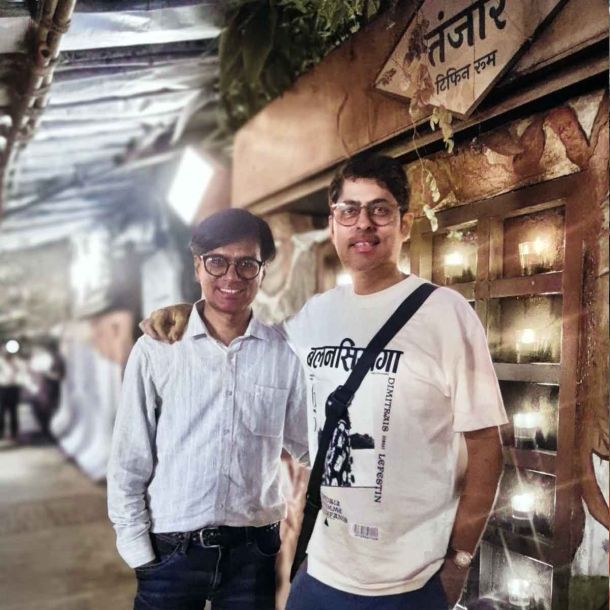More Coverage
Twitter Coverage
Satyaagrah
Written on
Satyaagrah
Written on
Satyaagrah
Written on
Satyaagrah
Written on
Satyaagrah
Written on
JOIN SATYAAGRAH SOCIAL MEDIA
"The bridge between reality and a dream is work": Anji Khad Bridge - An Engineering Marvel took 11 months to ready India’s first cable stayed rail bridge with 96 cables set constructed in the Reasi district of the Union territory of Jammu and Kashmir

India's First Cable-Stayed Rail Bridge: An Engineering Marvel. Union Railway Minister Ashwini Vaishnaw today shared a timelapse video of the making of the Anji Khad bridge, which is now ready for use. This is India's first cable-stayed rail bridge, which has 96 cables. The total length of cable strands is 653 km.
|
The timelapse video was shared with a caption that reads, "In 11 months, India's first cable-stayed rail bridge is ready. All 96 cables are set! #AnjiKhadBridge PS: Total length of cable strands 653 km".
Every single cable's placement, from the first to the last, is seen in the video.
The bridge is constructed in the Reasi district of the Union territory of Jammu and Kashmir under the most challenging Udampur-Srinagar-Baramulla-Rail Link (USBRL) Project of Indian Railways. The bridge is about 80 kilometers by road from Jammu.
India's railway infrastructure has come a long way since its inception. With the rapid development of the country's economy and the increasing demand for faster, more efficient modes of transportation, the Indian Railways has undertaken several ambitious projects to modernize its infrastructure and improve connectivity across the country. One such project that has garnered much attention is the construction of India's first cable-stayed rail bridge, connecting the Rameswaram and Pamban stations in Tamil Nadu.
The bridge, which has a total length of 2.05 kilometers and is 63 meters high above sea level, is a significant engineering feat. Its cable-stayed design reduces the number of piers required to support the bridge, making it more stable and reducing construction time and costs.
The bridge is located in the young fold mountains of the Himalayas, which have extremely complex, fragile, and daunting geological features in the form of faults, folds, and thrusts, besides the seismic proneness of the region. Detailed site-specific investigations were carried out by IIT, Roorkee, and IIT, Delhi.
Slopes of the mountain supporting one foundation of the main span have been stabilized by a special hybrid foundation on the Katra end due to space constraints.
The major portion of the bridge works, including the main pylon with a 40-meter-deep hybrid foundation, the central embankment, and the ancillary viaduct, were carried out on the Srinagar end.
The total length of the bridge is 725.5 meters. Considering the ease of construction and typical site conditions, the bridge has been divided into 4 parts: a 120 m long approach viaduct (called an "ancillary viaduct") on the Reasi side, a 38 m long approach bridge on the Katra end (CA2), the main bridge, crossing the deep valley (473.25 m cable-stayed portion), and the central embankment (94.25 m), located between the main bridge and an approach (ancillary) viaduct.
The main bridge over Anji is a cable-stayed bridge with a total length of 473.25 m and a main span of 290 m. Anji Khad Bridge connects tunnels T2 and T3 on the Katra-Banihal Section of the Udhampur-Srinagar-Baramulla Rail Link project.
This bridge has a single main pylon of 193 meters in height from the top of the foundation, standing at a height of 331 meters above the river bed.
|
The total length of the bridge is 725 m, consisting of the main bridge with a length of 473.25 meters, an ancillary viaduct of 120 meters in length, an approach bridge of 38 meters on the Katra end, and the central embankment of 94.25 meters in length.
It is an asymmetrical cable-stayed bridge balanced on the axis of a central pylon. The total deck width of the bridge is 15 meters.
The Anji Khad Bridge has the support of 96 cables, with cable lengths ranging from 82 m to 295 m. The micro piles of 40-meter depth all around the circumference of the 20-meter hybrid well foundation were used in the main pylon construction.
The bridge shall carry a single railway line plus a 3.75 m-wide service road; there is a 1.5m wide footpath on each side of the deck with an overall width of 15 m.
The Anji Khad Bridge has been designed to handle heavy storms with strong winds. The design wind speed considered is 213 kmph.
The project, which began in 2017, was a challenging task due to the region's unique geography and the bridge's technical specifications. The region is prone to high winds, and the bridge had to be designed to withstand these strong winds, as well as cyclones and earthquakes. To ensure the bridge's stability, advanced techniques were used in the design and construction, including computer simulations and wind tunnel testing.
The construction of the bridge was carried out by the Indian Railways' Konkan Railway Corporation Limited (KRCL), and the cost of the project was estimated to be around Rs 250 crore. The project also includes the construction of a double-line railway track, which will facilitate faster movement of trains and reduce the travel time between Rameswaram and the mainland.
The construction of the bridge is a significant milestone in India's railway infrastructure development and showcases the country's engineering prowess. The bridge's unique design and technical specifications make it an engineering marvel and a testament to India's capability to undertake such ambitious projects.
The Rameswaram-Pamban Rail Bridge: A Brief History
The Rameswaram-Pamban Rail Bridge, which connects the island town of Rameswaram to the mainland, was first opened in 1914. The bridge, which was designed by German engineer Scherzer, was a cantilever bridge that allowed boats and small ships to pass through its central section. The bridge was built to facilitate the movement of people and goods between the mainland and the island town of Rameswaram, which is a popular pilgrimage site.
Over the years, the bridge underwent several upgrades and renovations to accommodate the increasing traffic and ensure its safety. In 2007, the Indian Railways announced plans to replace the old bridge with a new one, which would be able to handle the increasing traffic and withstand the region's unique weather conditions.
The construction of the new bridge began in 2017, and it is now complete and ready to be inaugurated. The new cable-stayed bridge is a significant upgrade from the old cantilever bridge and is expected to enhance connectivity and boost tourism in the region.
The Design and Construction of the Cable-Stayed Bridge
The cable-stayed design of the new bridge is a departure from the old cantilever design of the previous bridge. The cable-stayed design reduces the number of piers required to support the bridge, making it more stable and reducing the construction time and costs. The bridge has a total length of 2.05 kilometers and is 63 meters high above sea level, making it one of the tallest bridges in India.
The bridge's design was challenging due to the region's unique geography and the bridge's technical specifications. The region is prone to high winds, and the bridge had to be designed to withstand these strong winds, as well as cyclones and earthquakes.
To ensure the bridge's stability, advanced techniques were used in the design and construction, including computer simulations and wind-tunnel testing
 Support Us
Support Us
Satyagraha was born from the heart of our land, with an undying aim to unveil the true essence of Bharat. It seeks to illuminate the hidden tales of our valiant freedom fighters and the rich chronicles that haven't yet sung their complete melody in the mainstream.
While platforms like NDTV and 'The Wire' effortlessly garner funds under the banner of safeguarding democracy, we at Satyagraha walk a different path. Our strength and resonance come from you. In this journey to weave a stronger Bharat, every little contribution amplifies our voice. Let's come together, contribute as you can, and champion the true spirit of our nation.
 |  |  |
| ICICI Bank of Satyaagrah | Razorpay Bank of Satyaagrah | PayPal Bank of Satyaagrah - For International Payments |
If all above doesn't work, then try the LINK below:
Please share the article on other platforms
DISCLAIMER: The author is solely responsible for the views expressed in this article. The author carries the responsibility for citing and/or licensing of images utilized within the text. The website also frequently uses non-commercial images for representational purposes only in line with the article. We are not responsible for the authenticity of such images. If some images have a copyright issue, we request the person/entity to contact us at This email address is being protected from spambots. You need JavaScript enabled to view it. and we will take the necessary actions to resolve the issue.
Related Articles
- "Real museums are places where Time is transformed into Space": PM Modi unveils the Mascot of the International Museum Expo 2023 - a contemporized version of the Dancing girl in Chennapatnam art style to celebrate the 47th International Museum Day
- In yet another milestone of BJP, Indian Railways First-Ever Freight Train Reaches ‘Rani Gaidinliu Railway Station’ marking a major breakthrough for railway authorities: Manipur
- In a monumental stride, India unveils the world's first BS-VI ethanol car, blending technology with agriculture and championing a vision for a sustainable, greener future while bolstering its economy & reinforcing its stand on environmental responsibility
- Twitter says it removed verified badge from Vice President Venkaiah Naidu’s account due to ‘inactivity’: Here is why their argument is flawed
- "Being a good neighbor is an art which makes life richer": Sri Lanka designates INR as official currency, President Wickremesinghe's aims to bolster relations and discuss key issues, amidst a history of mutual support during Sri Lanka's economic crisis
- Protestors demand change of movie name ‘Prithviraj’, burn Akshay Kumar’s effigy: Here’s the name they want
- Indian govt won’t be any different from British if Hindus can’t manage their own temples
- PETA India’s latest wisdom – Cows are killed for beef because you are drinking milk and eating cheese
- The forgotten temple village of Bharat: Maluti
- Do they have permanent treatments for diabetes, hypertension and insomnia yet: Baba Ramdev fires 25 questions at IMA
- Rahul Gandhi schooled by Externals Affair Minister Dr. S Jaishankar of history lessons and is condemned by Law Minister Kiren Rijiju for his remarks on the judiciary and Election Commission
- The Untold Story of the Brave Maratha Warrior Queen Ahilyabai Holkar!
- From joining ‘farmers’ protest to converting Rohingyas for Indian citizenship: How Christian groups have exploited the pandemic
- Bengal: Calcutta HC Asks NHRC To Examine Pleas Of People Displaced By Post-Poll Violence; Warns State Government Against Obstruction
- Thalapathy Vijay Beats Rajinikanth at Tamil Nadu Box Office With Master’s Fantastic Performance




























